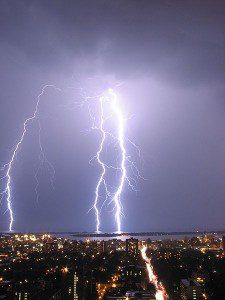Today kicks off Florida’s Severe Weather Awareness Week, January 30 – February 3, 2012, an important opportunity for Floridians to learn about the different weather hazards that frequently impact the state and how families and businesses can prepare for these natural events.

Each day focuses on a specific weather event. Monday’s focus is on lightning.
Lightning is one of nature’s most unpredictable weather phenomena. Meteorologists can forecast the general conditions that cause lightning, but no one can forecast the exact location or time of the next strike of lightning.
All thunderstorms contain lightning which can strike a person, tree or an object either on the ground or in the air. Lightning is among the top causes of weather-related fatalities in the United States. It kills nearly 60 people each year, and in Florida alone the average is seven fatalities per year. Lightning is often underrated as a life-threatening hazard, as it does not generate the same attention as compared to other forms of hazardous weather.
The 2012 Florida Severe Weather Awareness Week is a perfect time to note that our state, of all 50 states, is the lightning capital of the country. Averaging 1.4 million cloud-to-ground lightning strikes each year, no other state experiences more lightning strikes than Florida. Why does Florida have this distinction? Florida’s geography plays a large role, especially during the summer. Some of the elements that make Florida such a great place to live, such as sunshine and the ocean, play important roles in the development of thunderstorms. Thunderstorm activity peaks in the summer months in Florida, when most people are enjoying the warm weather, often causing the greatest number of lightning fatalities in a single state each year in the United States.
One characteristic that makes lightning so dangerous is its extensive range. Lightning has the ability to strike more than 10 miles away from the thunderstorm core, making it the first storm hazard to arrive and the last to leave, so while it may not be raining at your location, lightning can still reach you.
DID YOU KNOW? Contrary to belief, lightning CAN strike the same place twice and rubber shoes or tires DO NOT protect you from lightning strikes.
Thunder is a product of lightning. As lighting moves between the ground and thunderstorm, the air around the flash heats rapidly, to temperatures as high as 50,000°F – a temperature hotter than the surface of the sun. This sudden heating creates expansion of the air around the lightning bolt at speeds greater than the speed of sound. The expanding air breaks the sound barrier resulting in the explosive sound we know as thunder. Thunder is really just another form of a sonic boom. Because sound travels much slower than light, thunder is always heard after a flash of lightning.
Thunder travels at the speed of sound, which is roughly one mile every five seconds. You can determine how far away a flash of lightning is by counting the number of seconds that pass after observing a lightning bolt. For every five seconds that elapse, the lightning is one mile away. For example, if it takes 15 seconds for the thunder to reach you, then the lightning strike occurred about three miles away.
A “Bolt from the Blue” lightning strike is a flash which travels a relatively large distance in clear air away from the parent thunderstorm and then strikes the ground. These lightning flashes have been documented more than 25 miles away from the thunderstorm cloud. These events can be especially dangerous, as they appear to come from “clear blue sky.” Remember that if you can hear thunder, you are close enough to be struck by lightning. Being observant when outside is your first line of defense with lightning. A darkening cloud building high in the sky is often the first sign that lightning could occur.
Nearly half of all lightning deaths occur in open areas. Many people are struck when they go under a tree to keep dry during a storm. Outdoor water activities such as swimming, boating and fishing are equally as dangerous during lightning storms. Therefore, when thunderstorms are approaching, avoid outdoor activities as if your life depends on it – because it does!
The main tip to remember regarding lightning safety is: Seek shelter immediately because being outside is never safe during a thunderstorm!
At the first sign of lightning or sound of thunder, you should immediately head inside an enclosed structure. Even while inside, it is important to stay away from windows, any corded electrical devices and running water from faucets. Lightning can easily travel along phone lines, through other electrical devices and even through underground plumbing. The electrical current running through the wires or water can still electrocute a person while inside a building. When you can’t make it to an enclosed building, your next best course of action is to get into a vehicle with a hard-topped roof.
Although the National Weather Service does not issue specific lightning warnings, products such as the Hazardous Weather Outlook can indicate the threat levels for lightning in your area on any given day. Checking the forecast before venturing outside can help make the difference between life and death.
Lightning Safety Awareness Week is June 24 – 30, 2012 and more information about lightning hazards and what you can do to protect yourself and others can be found at www.lightningsafety.noaa.gov and www.FloridaDisaster.org.


